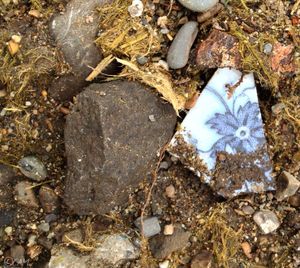Urban Archaeology: Unearthing pieces of Spokane’s past
It early spring, when the Spokane River was a wild spectacle, swollen with snowmelt and spring rains, thundering over the jagged basalt falls, pouring through the deep canyon at the edge of downtown, I could not stay away. I kept going back to stand on one of the bridges or walk along the trail that follows the river’s path through the city.
Sunday morning was my favorite time. There were fewer people around and I usually parked and walked along the north bank of the river on the newest section of the Centennial Trail beneath the Monroe Street Bridge and through the Kendall Yards development.
At one point, near the base of the big bridge, the construction of the trail extension had left broken soil on both sides of the path, an open scar of freshly turned dirt, sprinkled with grass seed that had not yet sprouted. As I walked I noticed a few pieces of debris that had been exposed by a scraper or the year’s unusually heavy rains: shards of white crockery, pieces of old china decorated with roses and other flowery designs, bits of glass that had turned lavender from decades of exposure to the sun. I was intrigued. I bent to pick up one piece and then another, and for a while I forgot about the river. The more I looked, the more I found.
I remember reading somewhere that the riverbanks on either side of the bridge, and the bridges that were there before the current span was built in 1911, had been expanded with fill, dirt and detritus pushed over the edge, a practice that continued for decades. A good bit of it was probably the result of the 1889 fire that decimated the heart of the downtown district at that time.
Now, having been plowed and pushed and scraped, yet again, time was upended and the evidence of the city’s human past was exposed revealing old patent medicine bottles, dishes that had broken and been discarded, tiles from houses and buildings.
Knowing that in a few weeks, with the return of warm weather, the grass would grow quickly and obscure this mosaic of the ordinary lives of the men, women and children who upon which the future had been built, I went back as often as I could. Not with a shovel or an eye for any kind of treasure, just to walk with my head bent and my eyes on the ground at my feet. Sure enough, once the grass grew thick and green, the bits and pieces disappeared.
The river in summer is more docile so I’m not there as often. But when I do walk the trail these days I am more aware of what is under my feet, that with every step I am walking on the hidden traces of other lives and other times.
Cheryl-Anne Millsap’s audio essays can be heard on Spokane Public Radio and on public radio stations across the U.S. She is the author of “Home Planet: A Life in Four Seasons” and can be reached at catmillsap@gmail.com
